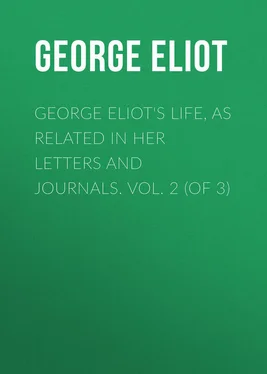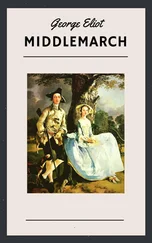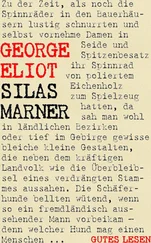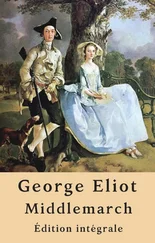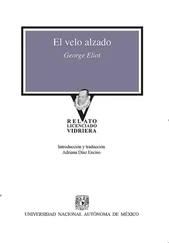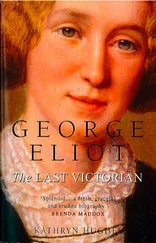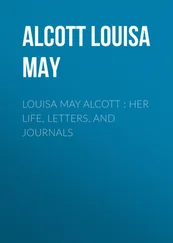George Eliot - George Eliot's Life, as Related in Her Letters and Journals. Vol. 2 (of 3)
Здесь есть возможность читать онлайн «George Eliot - George Eliot's Life, as Related in Her Letters and Journals. Vol. 2 (of 3)» — ознакомительный отрывок электронной книги совершенно бесплатно, а после прочтения отрывка купить полную версию. В некоторых случаях можно слушать аудио, скачать через торрент в формате fb2 и присутствует краткое содержание. Издательство: Иностранный паблик, Жанр: literature_19, foreign_antique, foreign_prose, на английском языке. Описание произведения, (предисловие) а так же отзывы посетителей доступны на портале библиотеки ЛибКат.
- Название:George Eliot's Life, as Related in Her Letters and Journals. Vol. 2 (of 3)
- Автор:
- Издательство:Иностранный паблик
- Жанр:
- Год:неизвестен
- ISBN:нет данных
- Рейтинг книги:3 / 5. Голосов: 1
-
Избранное:Добавить в избранное
- Отзывы:
-
Ваша оценка:
- 60
- 1
- 2
- 3
- 4
- 5
George Eliot's Life, as Related in Her Letters and Journals. Vol. 2 (of 3): краткое содержание, описание и аннотация
Предлагаем к чтению аннотацию, описание, краткое содержание или предисловие (зависит от того, что написал сам автор книги «George Eliot's Life, as Related in Her Letters and Journals. Vol. 2 (of 3)»). Если вы не нашли необходимую информацию о книге — напишите в комментариях, мы постараемся отыскать её.
George Eliot's Life, as Related in Her Letters and Journals. Vol. 2 (of 3) — читать онлайн ознакомительный отрывок
Ниже представлен текст книги, разбитый по страницам. Система сохранения места последней прочитанной страницы, позволяет с удобством читать онлайн бесплатно книгу «George Eliot's Life, as Related in Her Letters and Journals. Vol. 2 (of 3)», без необходимости каждый раз заново искать на чём Вы остановились. Поставьте закладку, и сможете в любой момент перейти на страницу, на которой закончили чтение.
Интервал:
Закладка:
April 16. – On Wednesday we walked to the Theresien Wiese to look at the "Bavaria" by sunset, but a shower came on and drove us to take refuge in a pretty house built near the Ruhmeshalle, whereby we were gainers, for we saw a charming family group: a mother with her three children – the eldest a boy with his book, the second a three-year-old maiden, the third a sweet baby-girl of a year and a half; two dogs, one a mixture of the setter and pointer, the other a turn-spit; and a relation or servant ironing. The baby cried at the sight of G. in beard and spectacles, but kept her eyes turning towards him from her mother's lap, every now and then seeming to have overcome her fears, and then bursting out crying anew. At last she got down and lifted the table-cloth to peep at his legs, as if to see the monster's nether parts.
Letter to Miss Sara Hennell, 17th April, 1858.
We have been just to take a sip at the two Pinacotheks and at the Glyptothek. At present the Rubens Saal is what I most long to return to. Rubens gives me more pleasure than any other painter, whether that is right or wrong. To be sure, I have not seen so many pictures, and pictures of so high a rank, by any other great master. I feel sure that when I have seen as much of Raphael I shall like him better; but at present Rubens, more than any one else, makes me feel that painting is a great art, and that he was a great artist. His are such real, breathing men and women, moved by passions, not mincing and grimacing, and posing in mere aping of passion! What a grand, glowing, forceful thing life looks in his pictures – the men such grand-bearded, grappling beings, fit to do the work of the world; the women such real mothers. We stayed at Nürnberg only twenty-four hours, and I felt sad to leave it so soon. A pity the place became Protestant, so that there is only one Catholic church where one can go in and out as one would. We turned into the famous St. Sebald's for a minute, where a Protestant clergyman was reading in a cold, formal way under the grand Gothic arches. Then we went to the Catholic church, the Frauen-Kirche, where the organ and voices were giving forth a glorious mass; and we stood with a feeling of brotherhood among the standing congregation till the last note of the organ had died out.
Journal, 1858.
April 23. – Not being well enough to write, we determined to spend our morning at the Glyptothek and Pinacothek. A glorious morning – all sunshine and blue sky. We went to the Glyptothek first, and delighted ourselves anew with the "Sleeping Faun," the "Satyr and Bacchus," and the "Laughing Faun" (Fauno colla Macchia). Looked at the two young satyrs reposing with the pipe in their hands – one of them charming in the boyish, good-humored beauty of the face, but both wanting finish in the limbs, which look almost as if they could be produced by a turning-machine. But the conception of this often-repeated figure is charming: it would make a garden seem more peaceful in the sunshine. Looked at the old Silenus too, which is excellent. I delight in these figures, full of droll animation, flinging some nature, in its broad freedom, in the eyes of small-mouthed, mincing narrowness.
We went into the modern Saal also, glancing on our way at the Cornelius frescoes, which seem to me stiff and hideous. An Adonis, by Thorwaldsen, is very beautiful.
Then to the Pinacothek, where we looked at Albert Dürer's portrait again, and many other pictures, among which I admired a group by Jordaens: "A satyr eating, while a peasant shows him that he can blow hot and cold at the same time;" the old grandmother nursing the child, the father with the key in his hand, with which he has been amusing baby, looking curiously at the satyr, the handsome wife, still more eager in her curiosity, the quiet cow, the little boy, the dog and cat – all are charmingly conceived.
April 24. – As we were reading this afternoon Herr Oldenbourg came in, invited us to go to his house on Tuesday, and chatted pleasantly for an hour. He talked of Kaulbach, whom he has known very intimately, being the publisher of the "Reineke Fuchs." The picture of the "Hunnen Schlacht" was the first of Kaulbach's on a great scale. It created a sensation, and the critics began to call it a "Weltgeschichtliches Bild." Since then Kaulbach has been seduced into the complex, wearisome, symbolical style, which makes the frescoes at Berlin enormous puzzles.
When we had just returned from our drive in the Englische Garten, Bodenstedt pleasantly surprised us by presenting himself. He is a charming man, and promises to be a delightful acquaintance for us in this strange town. He chatted pleasantly with us for half an hour, telling us that he is writing a work, in five volumes, on the "Contemporaries of Shakspeare," and indicating the nature of his treatment of the Shakspearian drama – which is historical and analytical. Presently he proposed that we should adjourn to his house and have tea with him; and so we turned out all together in the bright moonlight, and enjoyed his pleasant chat until ten o'clock. His wife was not at home, but we were admitted to see the three sleeping children – one a baby about a year and a half old, a lovely waxen thing. He gave the same account of Kaulbach as we had heard from Oldenbourg; spoke of Genelli as superior in genius, though he has not the fortune to be recognized; recited some of Hermann Lingg's poetry, and spoke enthusiastically of its merits. There was not a word of detraction about any one – nothing to jar on one's impression of him as a refined, noble-hearted man.
April 27. – This has been a red-letter day. In the morning Professor Wagner took us over his "Petrifacten Sammlung," giving us interesting explanations; and before we left him we were joined by Professor Martius, an animated, clever man, who talked admirably, and invited us to his house. Then we went to Kaulbach's studio, talked with him, and saw with especial interest the picture he is preparing as a present to the New Museum. In the evening, after walking in the Theresien Wiese, we went to Herr Oldenbourg's, and met Liebig the chemist, Geibel and Heyse the poets, and Carrière, the author of a work on the Reformation. Liebig is charming, with well-cut features, a low, quiet voice, and gentle manners. It was touching to see his hands, the nails black from the roots, the skin all grimed.
Heyse is like a painter's poet, ideally beautiful; rather brilliant in his talk, and altogether pleasing. Geibel is a man of rather coarse texture, with a voice like a kettledrum, and a steady determination to deliver his opinions on every subject that turned up. But there was a good deal of ability in his remarks.
April 30. – After calling on Frau Oldenbourg, and then at Professor Bodenstedt's, where we played with his charming children for ten minutes, we went to the theatre to hear Prince Radziwill's music to the "Faust." I admired especially the earlier part, the Easter morning song of the spirits, the Beggar's song, and other things, until after the scene in Auerbach's cellar, which is set with much humor and fancy. But the scene between Faust and Marguerite is bad – "Meine Ruh ist hin" quite pitiable, and the "König im Thule" not good. Gretchen's second song, in which she implores help of the Schmerzensreiche, touched me a good deal.
May 1. – In the afternoon Bodenstedt called, and we agreed to spend the evening at his house – a delightful evening. Professor Löher, author of "Die Deutschen in America," and another much younger Gelehrter , whose name I did not seize, were there.
May 2. – Still rainy and cold. We went to the Pinacothek, and looked at the old pictures in the first and second Saal. There are some very bad and some fine ones by Albert Dürer: of the latter, a full length figure of the Apostle Paul, with the head of Mark beside him, in a listening attitude, is the one that most remains with me. There is a very striking "Adoration of the Magi," by Johannes van Eyck, with much merit in the coloring, perspective, and figures. Also, "Christ carrying his Cross," by Albert Dürer, is striking. "A woman raised from the dead by the imposition of the Cross" is a very elaborate composition, by Böhms, in which the faces are of first-rate excellence.
Читать дальшеИнтервал:
Закладка:
Похожие книги на «George Eliot's Life, as Related in Her Letters and Journals. Vol. 2 (of 3)»
Представляем Вашему вниманию похожие книги на «George Eliot's Life, as Related in Her Letters and Journals. Vol. 2 (of 3)» списком для выбора. Мы отобрали схожую по названию и смыслу литературу в надежде предоставить читателям больше вариантов отыскать новые, интересные, ещё непрочитанные произведения.
Обсуждение, отзывы о книге «George Eliot's Life, as Related in Her Letters and Journals. Vol. 2 (of 3)» и просто собственные мнения читателей. Оставьте ваши комментарии, напишите, что Вы думаете о произведении, его смысле или главных героях. Укажите что конкретно понравилось, а что нет, и почему Вы так считаете.
